
Prosopis is a genus of flowering plants in the pea family, Fabaceae. It contains around 45 species of spiny trees and shrubs found in subtropical and tropical regions of the Americas, Africa, Western Asia, and South Asia. They often thrive in arid soil and are resistant to drought, on occasion developing extremely deep root systems. Their wood is usually hard, dense and durable. Their fruits are pods and may contain large amounts of sugar. The generic name means "burdock" in late Latin and originated in the Greek language.
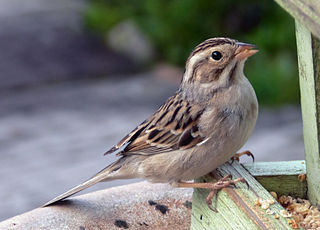
The clay-colored sparrow or clay-coloured sparrow is a small New World sparrow of North America.

Alcea is a genus of about 60 species of flowering plants in the mallow family Malvaceae, commonly known as the hollyhocks. They are native to Asia and Europe. The single species of hollyhock from the Americas, the streambank wild hollyhock, belongs to a different genus.
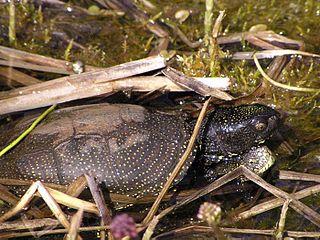
Emys is a small genus of turtles in the family Emydidae. The genus is endemic to Europe and North America.
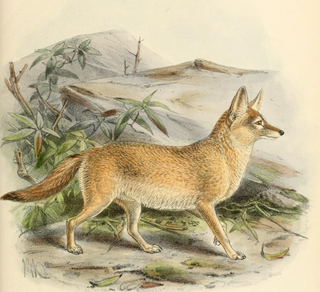
The pale fox is a species of fox found in the band of African Sahel from Senegal in the west to Sudan in the east. It is one of the least studied of all canid species, in part due to its remote habitat and its sandy coat that blends in well with the desert-like terrain.
Banksia pallida is a species of column-shaped shrub that is endemic to the south-west of Western Australia. It has densely hairy stems, linear leaves with three to five serrations on each side, pale yellow flowers in heads of up to eighty and egg-shaped to elliptical follicles.
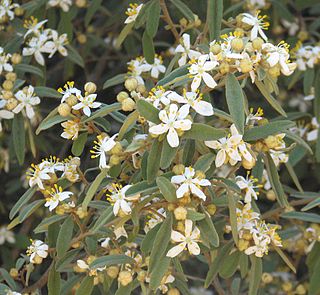
Asterolasia is a genus of seventeen species of erect or prostrate shrubs in the family Rutaceae, and is endemic to Australia. The leaves are simple and arranged alternately, the flowers arranged in umbel-like groups on the ends of branchlets or in leaf axils, usually with five sepals, five petals and ten to twenty-five stamens. There are seventeen species and they are found in all Australian mainland states but not in the Northern Territory.

Iris pallida, the Dalmatian iris or sweet iris, is a hardy flowering perennial plant of the genus Iris, family Iridaceae. It is native to the Dalmatian coast (Croatia) but widely naturalised elsewhere. It is a member of the subgenus Iris, meaning that it is a bearded iris, and grows from a rhizome.

Arctostaphylos pallida, commonly known as Pallid Manzanita, Oakland Hills Manzanita, and Alameda Manzanita, is an upright Manzanita shrub from the Ericaceae, or heath family. It is endemic to the eastern San Francisco Bay Area of Northern California.

Daseochaeta is a genus of moths of the family Noctuidae. The majority of species of this genus are currently under the valid genus Diphtherocome.
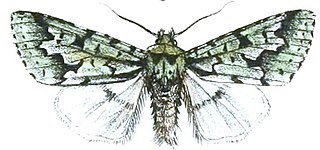
Diphtherocome is a genus of moths of the family Noctuidae.

Euspira is a genus of medium-sized sea snails, marine gastropod molluscs in the subfamily Polinicinae of the family Naticidae, the moon snails.

Pallidol is a resveratrol dimer. It can be found in red wine, in Cissus pallida or in Parthenocissus laetevirens.
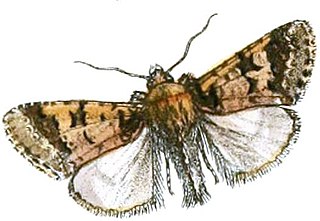
Diphtherocome discibrunnea is a species of moth of the family Noctuidae. It is found in India.

Lunatia is a genus of predatory sea snails, marine gastropod mollusks in the family Naticidae, the moon snails.
Deinandra pallida, called Kern tarweed, is a California species of plants in the tarweed tribe within the sunflower family. It has been found in the Coast Ranges, southern San Joaquin Valley, and Sierra Nevada foothills in Kern, Los Angeles, Santa Barbara, San Luis Obispo, Tulare, and Kings Counties. Isolated populations have been reported from farther north in Tuolumne County and northwestern Fresno County.
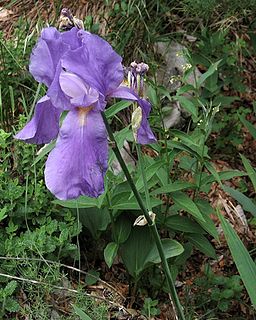
Iris pallida subsp. cengialti is a subspecies in the genus Iris, it is also in the subgenus Iris. It is a rhizomatous perennial, from Italy and Slovenia. It has yellowish-green, glaucous, lanceolate or ensiform leaves, tall stem, green flushed with purple spathes, 2 short branches, 2–3 scented flowers, in shades of violet, blue-violet, deep purple, blue-purple, deep blue-purple, pale purple, deep blue, to mid-blue. It has a yellow or orange tipped beard. It was originally published as Iris cengialti but then re-classified as a subspecies of Iris pallida, and known as Iris pallida subsp. cengialti, but it is often still called Iris cengialti. It is cultivated as an ornamental garden plant in temperate regions.

Iris pseudopallida is a species in the genus Iris, it is also in the subgenus of Iris. It is a rhizomatous perennial from Croatia. It has flat, curved of sickle-shaped leaves, tall slender stems, 3–8 fragrant flowers, in shades of violet, or pale violet flowers, mauve, lavender, purple, yellow or white, between May and June. The iris was originally thought to be a separate species, but later classified as subspecies of Iris pallida, known as Iris pallida subsp. pseudopallida, although in Croatia, it is still known as Iris pseudopallida. It is cultivated as an ornamental plant in temperate regions, especially in the Balkan regions.

Exaiptasia is a genus of sea anemone in the family Aiptasiidae, native to shallow waters in the temperate western Atlantic Ocean, the Caribbean Sea and the Gulf of Mexico. It is monotypic with a single species, Exaiptasia pallida, and commonly known as the brown anemone, glass anemone, pale anemome, or simply as Aiptasia.

Dipsastraea pallida is a species of colonial stony coral in the family Merulinidae. It is found in tropical waters of the Indian and Pacific Oceans. This is a common species of coral with a widespread distribution, and the main threat it faces is from the destruction of its coral reef habitats. It is rated as a "least-concern species" by the International Union for Conservation of Nature. This species was first described in 1846 as Favia pallida by the American zoologist James Dwight Dana; it was later transferred to the genus Dipsastraea, but some authorities continue to use the original name.


















